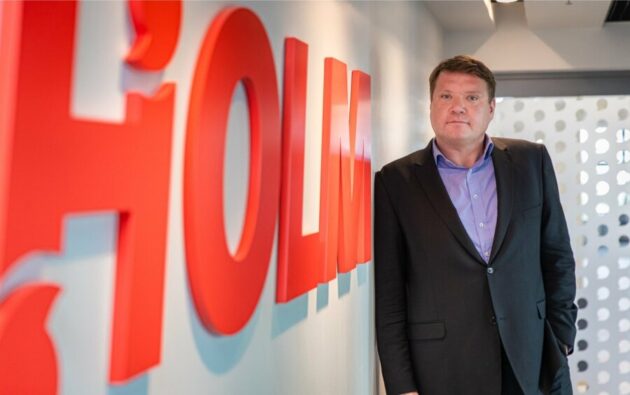Holm Bank: Estonia’s Youngest Bank, International and Innovative
Source: Äri-IT Autumn 2021
Holm Bank, operating without much fanfare, has been going full speed ahead despite the pandemic.

Savings from Estonians, Germans, and Austrians have been deposited, the bank is gaining recognition in Latvia’s installment and auto loan market, a digital credit card is offered in Sweden, and the next target group in Estonia is medium-sized and large business clients. Holm Bank is most likely the only Estonian bank that found several thousand clients in Sweden in less than a year. These people are a sweet segment for any bank: mainly 20-50 years old, with the greatest needs and desires. This type of client is interested in furniture, bicycles, children’s goods, clothing, home appliances… The innovative digital credit card that Holm Bank offers in Sweden is similar in essence to the local Liisi installment plan, but it is even more convenient: you download the app to your phone, set the credit amount and repayment period, and you can make the purchase. Recently, a unique feature was added to Holm’s digital app: in addition to the digital credit card, you can transfer the loan amount directly to a person’s bank account.
Going to Sweden is a clear sign that Holm’s ambitions, which received a banking license only in 2019, extend beyond Estonia. Strong experience gives them courage: although their banking experience is only two years, they have been operating as a financial company for over a quarter of a century. Installment plans have been offered under the Liisi brand since 1995. You won’t find a store or e-shop in Estonia where you can’t arrange a Liisi installment plan – it is offered by over 2,000 shopping locations. Over 350,000 customers served over time is a baggage that any company can be proud of.
“Liisi installment has always been in a very strong position in Estonia, but we are all fighting for the same limited customer base. Since the birth of the bank, we have had a clear goal that the bank is not only made for the Estonian market,” says Roul Tutt, the bank’s business development manager. “We decided that we will expand internationally and new markets must emerge.”
Offering installments in Latvian stores was a logical step, as Holm Bank’s owner, Haapsalu entrepreneur Arne Veske, already had a company there. The market share in Latvia is still small, but it is growing steadily. However, instead of the Finnish market, where Estonian companies tend to go easily, Holm chose the ambitious Sweden. Although this market is not easy, there were several prerequisites: Swedish consumers are used to credit products, long-term economic growth has encouraged consumption growth, incomes are high, and payment behavior is generally good. Since this is a digital product, awareness and widespread use of mobile internet were also important.
Digital channels have also been used in Sweden to reach customers. “In Sweden, we targeted very precisely those who feel at home in the digital world,” says the bank’s marketing manager Anu Art. “Our channels were Facebook, Instagram, Google’s outputs, App Store, etc… As a newcomer to the Swedish market, we started by introducing the product: what a digital credit card is and why someone might need it.”
And more. Holm’s experience in Sweden shows that people no longer always prefer their usual bank. On the contrary, banking products are becoming increasingly international. The digital credit card is a great opportunity for Holm Bank. In parallel with securing a position in Sweden, the launch of a digital credit card is already being prepared in the next European countries.
Deposits from German and Austrian Residents
Another confirmation that banking products have become international overnight is the holding of savings from German and Austrian depositors at Holm Bank. Deposits reach Holm from the international market thanks to the Raisin intermediary platform, which also manages the pension money of Siemens Group employees and mediates the savings of Western Europeans to several banks, including those in the Baltics.
The safety of depositors is ensured by the European Union Deposit Guarantee Law, according to which a deposit guarantee of up to 100,000 euros applies in credit institutions. Therefore, Germans and Austrians also dare to place their millions in 100,000 euros in several banks, including Holm.
Of Holm’s depositors, who have a balance sheet of 90 million euros today, two-thirds are Western Europeans, the rest are local depositors.
Together with the Client
Holm Bank continues to offer services already known under the Liisi brand: installment, small loan and credit card. Under the newer Holm brand, customer savings are deposited, virtual credit products are offered, and business loans are offered to companies. Initially, the clients are mainly small businesses, but the goal is to bring much larger companies among the clients.
The bank does not have a special magic trick for this. Or, as the company’s founder Arne Veske has very clearly stated, there is one magic trick: to serve customers with dignity and politeness. The bank’s CEO and chairman of the board Rauno Klettenberg explains: “The question is how you treat the customer. Do you follow the contract with your finger or do you try to understand him and realize that the difficulties are temporary. The client is not left to the mercy of fate even in difficult times, economic downturns are tried to be overcome together – this has consistently grown our customer base.”
Holm Bank does not have offices, communication with the client takes place via the internet and telephone. This is seen as an advantage, not a disadvantage, in the bank. “Face-to-face communication is no longer very important today. We consider it more important that the client’s financial question receives a quick answer,” says Klettenberg. Therefore, the corona era has not significantly affected the bank’s business activities – there are no bank halls, there are no closing problems either.
However, in order to meet one of the most important requirements of modern banking – to offer the customer a banking product that suits him quickly and conveniently – investing in technological solutions is inevitable.
An Unusual Solution Was Chosen in Technology
The predictions from older banks that Holm Bank will never operate as a bank, because the IT solution that a modern bank needs is financially overwhelming for a new starter, did not hold true.
“True, the solutions that other banks use are expensive,” admits Holm’s IT manager Alvar Pihlapuu. “But big banks are often stuck in their technological heritage. It is expensive to maintain, but it is even more expensive to give it up. Therefore, they carry it with them.”
According to him, Holm Bank’s owner and board were willing to build a new and innovative banking system from scratch. The technology interest of the bank’s founder, TTÜ-educated Arne Veske, who was a close friend of computers at a time when they were room-sized, probably played a role here. “Simply put – Holm Bank does not have its own servers, all infrastructure is scalable as code in the Amazon cloud environment across all products and countries. We don’t have to think about how to distribute the load across borders and transfer data,” says Pihlapuu. “We have been developing a new system for almost a year and two of the three main products – small loans and credit cards – are already on the new system, deposit and installment are waiting in line. The partner interface of the latter is planned to be made as user-friendly as possible.”
From there on, the way is open for all products and countries: all technology is solved with automatic installation and automatic tests, which allows saving time for testers and analysts in the development cycle.
This meant re-adaptation and re-learning for all bank employees, and everything has not always been easy. But today they are used to the fact that the IT development process is agile – business people are involved, giving the necessary input from the bank’s business needs. The IT side prepares the solution and immediately puts it to the test.
The IT manager thanks three strong partners: BCS Itera AS, which provides the ERP solution, Codeborne OÜ, one of the strongest players in the backend field, and Mountbirch OÜ, the frontend partner with whom the new solutions have been developed.
The bank’s financial accounting is done in the MS Business Central program. Thanks to the fact that the Amazon cloud is directly connected to Microsoft’s cloud, accounting is done on a cloud basis. “We are pleased that we can choose the time and place of work and share rights over the cloud. The program is user-friendly and can be customized to your needs. We use all modules on a daily basis, except for the warehouse function, because the bank does not have a warehouse,” says finance manager Kristi Luite. “In the old days, the bank system and the general ledger operated separately and the systems had to be reconciled with each other at certain intervals. There could be shortcomings in terms of internal control. Now, when BCS Itera connected the clouds, the entries related to the portfolios are made regularly at the change of day and they move directly to our accounting system. This is a considerable saving of human and time resources. The information needed for consolidation is available to the parent company in the cloud at any time, its monitoring is done daily. The practical benefit of the development is that management reporting is available in real time, we are more operational and can make more informed decisions,” she adds.
So, equipped with new technology, the Holm Bank team is full of desire to grow and develop, because some of the developments in recent years have been very favorable for the bank. “For example, we have seen the rise
HOLM BANK AS – A Company with a Rich History
2019 marked a milestone for Haapsalu entrepreneur Arne Veske, the bank’s founder and owner: Holm Bank AS was established, and it became the first company in Estonia to receive a credit institution license from the European Central Bank, enabling it to provide financial services across Europe.
The bank’s name is deliberate. “Holm” refers to the small islands dotting the sea around Haapsalu. While the name may not yet be widely recognized in Estonia, the bank has a distinguished history. Its predecessor, Koduliising OÜ, has offered Liisi installment plans since 1995, available in over 2,000 stores and online shops. The company has partnerships with more than 1,000 retailers.
In 2019, Rauno Klettenberg, a veteran of the financial sector with over 15 years of experience, including leadership roles at Handelsbanken’s local branch and the Tallinn Stock Exchange, became Holm Bank’s CEO.
The bank’s consolidated profit for 2020 was €1,065 million, with the parent company’s shareholder’s share at €1.27 million. Profits earned last year were reinvested in the company.
